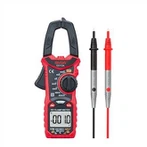There are two types of leakage current: line leakage and electrical equipment leakage;
①Line leakage refers to the leakage current that the insulation performance of the line itself is reduced and a loop is formed with the ground when the load in the line is not connected to the power supply.
②Electrical equipment leakage refers to the leakage current formed by the insulation resistance value of the coil inside the equipment and the earth after the equipment is powered on.
No matter what multimeter is, the insulation resistance value of the measured line is not standard (the insulation resistance value of the measurement line must be a dedicated megohmmeter), even if you use a multimeter to measure the insulation resistance value of the line, it is only a reference value , and is very different from the actual insulation resistance value; because the multimeter itself is a 9V stacked battery, only a 9V DC voltage is applied to the line measurement, while the voltage of the AC power supply line is 220V and 380V.
If you are using a digital multimeter, you can dial the multimeter to the AC current gear.
(1) The leakage current of the line is relatively simple to measure. The current measured by the multimeter is connected in series with the line or equipment. When the line is not connected to the power supply at the load, the lower end of the output of the power supply circuit breaker (the line connector needs to be disconnected) is directly connected in series. In the circuit breaker output and line connector, note that the ordinary digital multimeter has just set the current range to a larger value. The above picture shows that the multimeter I use automatically switches the range. The current value measured at this time is the leakage current in the line.
It is very troublesome to measure the leakage of electrical equipment, because the installation of electrical equipment shells are basically grounded by mechanical devices. If you use a multimeter to measure leakage, you need to vacate the electrical equipment. When the equipment is powered on, use the multimeter to connect one end to the ground, and the other to the ground. One end is in contact with the electrical equipment, and the current measured by the multimeter is the leakage current.
(2) How to measure the live wire in the line with a digital multimeter? First, switch the digital multimeter to the AC~750V range, use the red test lead wire or the black test lead wire of the multimeter, and wrap it around 3~5 turns on your hand, and insert the other test lead into or contact the metal pile head of the conductor. or into the socket.
This is the principle that the distributed capacitance is formed by the contact of the wire with the human body (the more conductor turns, the greater the capacitance formed with the human body), and the sensitivity of the digital multimeter itself is higher than that of the pointer multimeter. Therefore, the larger the displayed value of the response to the digital multimeter.
The above 1 is a measurement method that I often use. Generally, I wind it on my hand 4 times. At this time, the measurement result is ~57V. There is no doubt that it is the live wire. The test lead wire wrapped around the hand does not move, and then use the black test lead to contact the other ground wires N and PE respectively to protect the ground.
So this is the principle that the distributed capacitance will be formed by the contact of the wire with the human body (the more conductor turns, the greater the capacitance formed with the human body), and the sensitivity of the digital multimeter itself is higher than that of the pointer multimeter. Therefore, the larger the displayed value of the response to the digital multimeter.






